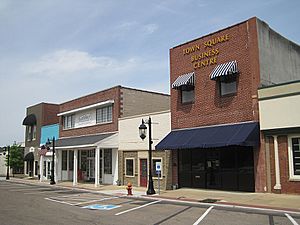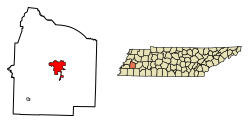Brownsville, Tennessee facts for kids
Quick facts for kids
Brownsville, Tennessee
|
|||
|---|---|---|---|

Brownsville business district
|
|||
|
|||
| Motto(s):
Heart of the Tennessee Delta
|
|||

Location in Haywood County, Tennessee
|
|||
| Country | United States | ||
| State | Tennessee | ||
| County | Haywood | ||
| Area | |||
| • Total | 9.86 sq mi (25.54 km2) | ||
| • Land | 9.86 sq mi (25.54 km2) | ||
| • Water | 0.00 sq mi (0.00 km2) | ||
| Elevation | 390 ft (119 m) | ||
| Population
(2020)
|
|||
| • Total | 9,788 | ||
| • Density | 992.80/sq mi (383.30/km2) | ||
| Time zone | UTC-6 (Central (CST)) | ||
| • Summer (DST) | UTC-5 (CDT) | ||
| ZIP code |
38012
|
||
| Area code(s) | 731 | ||
| FIPS code | 47-08920 | ||
| GNIS feature ID | 1278634 | ||
Brownsville is a city in Haywood County, Tennessee, United States. It's also the main town, or county seat, of Haywood County. In 2020, about 9,788 people lived there. The city gets its name from General Jacob Jennings Brown, who was an American officer during the War of 1812.
Contents
History of Brownsville
Brownsville grew because of cotton farms and agriculture in the southern United States. It's located near the Hatchie River, which flows into the Mississippi River. This river was once a key way to transport cotton to markets. The town is known for its many old homes built before the Civil War. These homes belonged to wealthy farmers, and some farms have been in the same families for generations.
The Tabernacle Campground was started in 1826 by Reverend Howell Taylor. This was soon after Brownsville itself was founded. Today, it's still used for an annual "camp-meeting" for Taylor's family members.
Brownsville's synagogue, Temple Adas Israel, was built in 1882. It was founded by German Jewish immigrants in the 1860s. This building is on the National Register of Historic Places. It's thought to be the oldest synagogue in Tennessee. It's also a rare example of a synagogue built in the Gothic Revival style.
After the Civil War, during a time called Reconstruction, some white people in the late 1800s tried to regain control. They created Jim Crow laws to treat African Americans unfairly. These laws made it hard for Black people to vote or have equal rights. By the early 1900s, most Black people in Tennessee couldn't vote.
Even though Black people were a large part of Haywood County in the late 1930s, they couldn't use their political power. In 1939, some Black residents in Brownsville started a local chapter of the NAACP. The NAACP is a group that works for civil rights. They wanted to register and vote in the 1940 presidential election.
In June 1940, people in the group received threats. A man named Elisha Davis was taken by a large white group. They wanted to know the names of NAACP members. He and his family had to leave town, losing everything they owned.
On June 20, 1940, Elbert Williams, who was the secretary of the NAACP chapter, was questioned by police. He was never seen alive again. His body was found in the Hatchie River a few days later. Elbert Williams is believed to be the first NAACP member to be killed for his civil rights work. Other members also had to leave town because they feared for their lives.
The NAACP investigated and asked the government to look into Williams' murder. FBI agents came to Brownsville to protect Black people who wanted to vote. However, people were still scared because no one was punished for Williams' death. The NAACP reported that no Black people registered to vote that year.
In 2015, a special historical marker was approved to honor Elbert Williams. It was placed in Brownsville on June 20, 2015. This was 75 years after Williams' death. The president of the NAACP, Cornell W. Brooks, spoke at the event.
Geography and Nature
Brownsville covers about 9.1 square miles (25.54 square kilometers) of land.
The city is on the edge of the New Madrid Seismic Zone. This area has a higher risk of earthquakes.
The Hatchie River flows through Brownsville. It's the longest free-flowing river that feeds into the lower Mississippi River. It also has the biggest forested floodplain in Tennessee. The river is home to many kinds of fish, including 11 types of catfish. You can also find the alligator snapping turtle there. The Nature Conservancy group called the Hatchie River one of the "great places" to protect. It's also a "scenic river" under Tennessee law.
Brownsville's Climate
The weather in Brownsville has hot, humid summers. Winters are usually mild to cool. According to the Köppen Climate Classification system, Brownsville has a humid subtropical climate. This is often called "Cfa" on climate maps.
Population Facts
| Historical population | |||
|---|---|---|---|
| Census | Pop. | %± | |
| 1850 | 971 | — | |
| 1860 | 1,137 | 17.1% | |
| 1870 | 2,457 | 116.1% | |
| 1890 | 2,516 | — | |
| 1900 | 2,645 | 5.1% | |
| 1910 | 2,882 | 9.0% | |
| 1920 | 3,062 | 6.2% | |
| 1930 | 3,204 | 4.6% | |
| 1940 | 4,012 | 25.2% | |
| 1950 | 4,711 | 17.4% | |
| 1960 | 5,424 | 15.1% | |
| 1970 | 7,011 | 29.3% | |
| 1980 | 9,307 | 32.7% | |
| 1990 | 10,019 | 7.7% | |
| 2000 | 10,748 | 7.3% | |
| 2010 | 10,292 | −4.2% | |
| 2020 | 9,788 | −4.9% | |
| Sources: | |||
People in Brownsville (2020 Census)
In 2020, the 2020 United States census counted 9,788 people living in Brownsville. There were 4,001 households and 2,428 families.
| Race | Num. | Perc. |
|---|---|---|
| White (non-Hispanic) | 2,427 | 24.8% |
| Black or African American (non-Hispanic) | 6,507 | 66.48% |
| Native American | 18 | 0.18% |
| Asian | 16 | 0.16% |
| Pacific Islander | 4 | 0.04% |
| Other/Mixed | 235 | 2.4% |
| Hispanic or Latino | 581 | 5.94% |
Education in Brownsville
Brownsville's schools are part of the Haywood County School system. There are six schools:
- Anderson Early Childhood Center (Pre-K and Kindergarten)
- Haywood Elementary School (grades 1 and 2)
- East Side Elementary School (grades 3 and 4)
- Sunny Hill Intermediate School (grades 5 and 6)
- Haywood Middle School (grades 7 and 8)
- Haywood High School (grades 9 through 12)
The school system also has online learning options. The Tennessee College of Applied Technology-Jackson has a branch in Brownsville. The University of Tennessee system and Tennessee State University also have agricultural programs here.
In the past, Brownsville had several colleges. The Brownsville Female Seminary started in 1842. The Brownsville Baptist Female College opened in 1851. This college was one of the few in the area to survive the Civil War. A future governor of Missouri, Joseph Folk, even graduated from this "female" college!
Brownsville also had Dunbar School, which opened in the 1890s for African American students. After a fire, it became George Washington Carver High School.
The Elma Ross Public Library serves Brownsville today. It was built in 1992 with help from the county, city, and a local helper named David William Ross. Before that, Brownsville had a Carnegie Library, built in 1912 with a grant from Andrew Carnegie. This old library building is now used by the Chamber of Commerce.
Brownsville's local newspaper is the Brownsville States-Graphic. It was formed in 1900 from earlier newspapers. The very first newspaper in Brownsville, The Phoenix, was printed in 1837.
Arts and Culture
The Tina Turner Museum is in Brownsville. It's dedicated to the famous singer Tina Turner, who was born nearby in 1939. The museum is in a schoolhouse that Tina Turner once attended. Next to it is the childhood home of blues musician Sleepy John Estes.
The Ann L. Marks Performing Arts Center is in the College Hill Historic District. This theater is named after Ann Liberman Marks, a local writer who supported the arts. The theater, built in 1920, can hold 420 people. It was damaged in a storm in 2020 but reopened in 2024 after repairs.
Brownsville is home to The Mindfield, which is the largest sculpture in Tennessee. Local artist and author Billy Tripp has been building it by himself since 1989. The sculpture is 127 feet tall and about 300 feet long!
In 2017, an amphitheater was built in downtown Brownsville. It's a place for many events, like concerts, fundraisers, and public parties. Free concerts are often held there in the summer to show off local talent.
Brownsville once had a large, three-story opera house. Many traveling shows performed there, along with local talent shows and dances. Famous musicians like W. C. Handy and John Philip Sousa even performed at this opera house. Sadly, it was destroyed by a fire in 1931.
Notable People from Brownsville
Many interesting people have connections to Brownsville:
- Henry Whitelaw Bond (1848–1919), a judge for the Missouri Supreme Court
- William W. Bond (1884–1975), a lawyer and Speaker of the Tennessee House of Representatives
- Son Bonds (1909–1947), a musician
- Vic Bradford (1915–1994), a Major League Baseball player
- Patsy Bruce (1940–2021), a country-western songwriter
- Paul Burlison (1929–2003), a rockabilly guitar player
- Tony Delk (born 1974), a basketball player and coach
- Pat Estes (1872–1947), an attorney and college football player
- Clay Evans (1925–2019), a gospel singer and pastor
- Rockey Felker (born 1953), a football player and coach
- Joseph Folk (1869–1923), a governor of Missouri
- Alfred A. Freeman (1838–1926), a politician and judge
- Richard Halliburton (1900–1939), an adventurer and author
- Thomas J. Henderson (1824–1911), a U.S. Representative
- Eugene Holmes (1932–2007), an opera singer
- Trell Hooper (born 1961), a former professional football player
- Miles Vandahurst Lynk (1871–1956), who started the first medical journal by an African American
- Edith Mitchell (1947–2024), an oncologist and brigadier general in the U.S. Air Force
- Corey Moore (born 1974), a professional football player
- Hambone Willie Newbern (1901–1965), a country blues musician
- Hammie Nixon (1908–1984), a blues musician
- David A. Nunn (1833–1918), a U.S. Representative
- Jimmy Oldham (1893–1930), a Negro League baseball pitcher
- Yank Rachell (1910–1997), a country blues musician
- Brett Scallions (born 1971), the lead singer of the band Fuel
- Geneva Smitherman, a professor who helped start a doctoral program in African American studies
- Harold M. Shaw (1877–1926), a silent film director
- Nettie Barcroft Taylor (1914–2016), a state librarian
- Polk Taylor (1833–1934), a Methodist minister
- Quintard Taylor (born 1948), a historian who founded BlackPast.org
- Zachary Taylor (1849–1921), a U.S. Representative
- Jim Thaxton (born 1949), a football player
- Billy Tripp (born 1955), an author and artist
- Tina Turner (1939–2023), a world-famous singer and actress
- Leroy Tyus (1916–1998), a politician and real estate developer
- Jarvis Varnado (born 1988), a professional basketball player
- Dwight Waller (1945–2021), a professional basketball player
- T. I. Webb Jr. (1880–1975), a golfer
- William Ridley Wills (1871–1949), who founded an insurance company
- William Ridley Wills (1897–1957), an American poet and novelist
See also
 In Spanish: Brownsville (Tennessee) para niños
In Spanish: Brownsville (Tennessee) para niños




